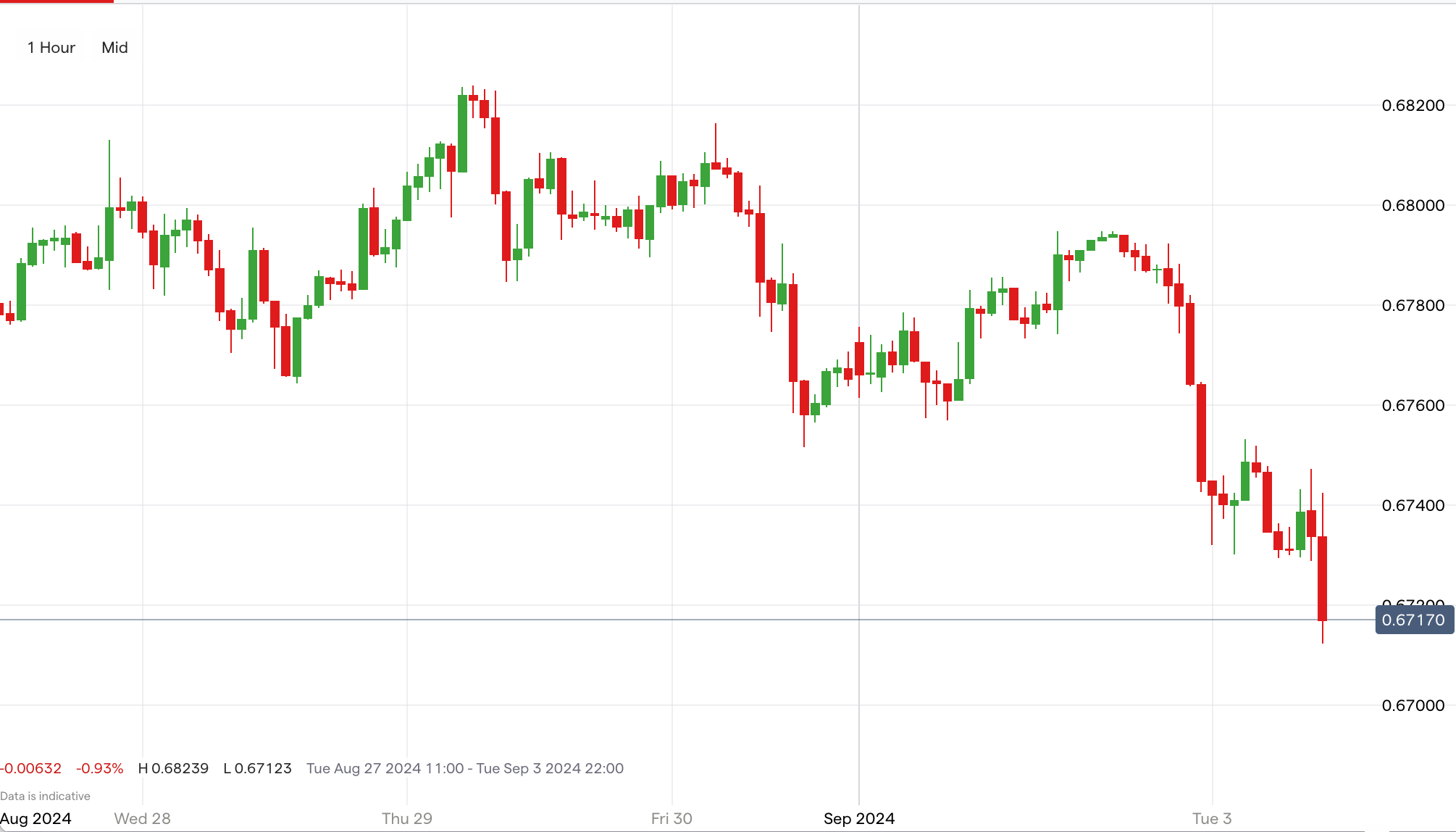AUD/USD slides off highs as USD makes steady rebound
The AUD/USD pair dips amid softer commodity prices and anticipation of Australia's GDP data, while the US dollar strengthens ahead of key employment figures. Insights into labor market data and expectations outlined.

Key points
- AUD/USD drops to .6717 amidst softer commodity prices and upcoming Australian GDP data
- US dollar strengthens, reaching a two-week high
- Upcoming labor market data: Job openings, initial jobless claims, NFP, and unemployment rates
- Non-Farm Payrolls are forecasted to trend up to 160,000 in September
- US employment data this week crucial for AUD/USD pricing and potential dollar movement
AUD/USD reaches low of .6717 ahead of Australian GDP data release
Softer commodity prices, such as iron ore, are weighing on the aussie’s value since the Australian economy relies heavily on exports. This comes ahead of Australia’s second quarter GDP data release tonight at 9:30 pm ET. Additionally, Governor Michele Bullock’s commentary on monetary policy the following day is anticipated to reflect the Reserve Bank of Australia’s (RBA) hawkish stance due to inflation. Predictions point to a 0.2% GDP QoQ growth, an increase from the 0.1% growth in the first quarter. Additionally, AUD/JPY has shown a significant decrease of 1.87%.
AUD/USD price history

US dollar strengthens ahead of key employment data
The USD has strengthened not just against the AUD but also other major currencies after Labor Day Weekend, with a positive bounce in PMI. Much of this strength is driven by anticipation for upcoming data. The US dollar has reached its highest level in nearly two weeks as the economic and monetary outlook is reassessed. The ISM Manufacturing PMI, a key indicator, showed contracted factory activity at a rate of 47.2 for the fifth consecutive month, despite a slight uptick from July’s value of 46.8. This has extended the weak momentum in US manufacturing and added to the suspicion of potential rate cuts on the horizon.
What to expect from August labor market data
Traders are looking forward to a series of labor market data releases: Job Openings on Wednesday, Initial Jobless Claims on Thursday, and Non-Farm Payrolls and Unemployment data on Friday. To give some background, Job Openings data as of June 2024 decreased from 8.23M to 8.18M. Additionally, Initial Jobless Claims as of August 24th fell to 231k from 233k the previous week. Non-Farm Payrolls as of July 2024 increased by 114k, though recent updates from the BLS revealed weaker job growth than initially forecasted. Finally, Unemployment rose to 4.3% in July, exceeding expectations and marking a significant increase from the previous year’s 3.5%. Forecast data suggests initial jobless claims could rise to 250k, Non-farm Payrolls may trend up to 160,000, and unemployment might reach 4.2% on Friday.
What’s next for AUD/USD?
The short-term pricing for AUD/USD is particularly reliant on US data this week. Employment data is the last major clue before the September FOMC meeting, which will determine the pace of rate cuts. AUD/USD could move on the JOLTs Job Opening number on Wednesday if it misses the mark significantly, potentially giving warning to Friday’s Non-Farm Payroll release. The expected rebound in Non-Farm Payroll numbers and decrease in Unemployment could quell the outside chance of a 50-bps cut in September that’s currently priced in, potentially bolstering the US dollar further.
How to trade AUD/USD
- Open an account to get started, or practice on a demo account
- Choose your forex trading platform
- Open, monitor, and close positions on AUD/USD
Trading forex requires an account with a forex provider like tastyfx. Many traders also watch major forex pairs like EUR/USD and USD/JPY for potential opportunities based on economic events such as inflation releases or interest rate decisions. Economic events can produce more volatility for forex pairs, which can mean greater potential profits and losses as risks can increase at these times.
You can help develop your forex trading strategies using resources like tastyfx’s YouTube channel. Our curated playlists can help you stay up to date on current markets and understanding key terms. Once your strategy is developed, you can follow the above steps to opening an account and getting started trading forex.
Your profit or loss is calculated according to your full position size. Leverage will magnify both your profits and losses. It’s important to manage your risks carefully as losses can exceed your deposit. Ensure you understand the risks and benefits associated with trading leveraged products before you start trading with them. Trade using money you’re comfortable losing.
